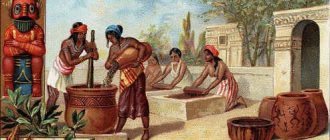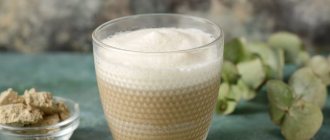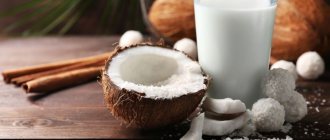Classic espresso brewed in Turkish will not surprise anyone. But if you add aromatic herbs and ground spices to it, you will be able to add oriental notes to the ceremony. There are countries where drinking this drink is considered a cult.
To enhance the coffee aroma and taste, it is recommended to follow the advice of professionals and brew it with the addition of spices and aromatic plants.
Universal Supplements
The most common spices that are added to many dishes are also good for coffee. Salt or black pepper added in small quantities (a few grains) will not add new flavor accents, but will only add expressiveness.
Seasonings significantly change the drink, giving it completely new notes.
Typically, spices are added to coffee if its own aroma and taste are neutral and not very expressive. You shouldn’t put extraneous ingredients into an expensive elite variety: you need to drink it neat for the rich bouquet to reveal itself.
The nature of acidity and its intensity
Acidity is most often confused with sour taste. This is not entirely true - acidity emphasizes the high quality of the drink. Assess when the coffee has cooled to approximately 60ºC. Pay attention to its intensity and quality. Moreover, high intensity does not imply high quality and vice versa.
Acidity can be either with positive characteristics: pure, complex, bright, juicy, soft, tartaric, sparkling, apple, phosphoric, citric. So it is with negative characteristics: caustic, flat, unripe, enzymatic, vinegary, herbaceous, sour, muted, aggressive, simple.
Popular spices
Spicy aromas make the coffee bouquet richer and more intense. You can add spices to your coffee, which are found in almost every kitchen, so you don’t have to buy anything to experiment. The drink is brewed in a Turk.
- Don't miss: How to brew Turkish coffee on a gas stove
All spices have a concentrated taste and aroma, so they are used in very small quantities. Below is the dosage for 1 serving (200 ml).
Cinnamon. The sweetish smell softens excessive strength or acidity. Add a pinch of cinnamon powder at the end of cooking and let it sit for 1 minute. Goes well with salt and honey.
Vanilla. An easily recognizable smell can turn ordinary coffee with milk into an exquisite delicacy. Seeds from 1/4 vanilla pod are heated in milk and then poured into the finished drink.
Carnation. To obtain a subtle aroma, only clove buds are taken, and the stems have a sharper smell. One piece is added at the end of cooking.
Nutmeg. It enhances the natural bitterness of coffee, making it more tart, while muting the drink’s own aroma. Can save failed or old coffee beans. It is important not to overdo it: take the powder at the very tip of the knife and add it at the beginning of cooking.
Cardamom. Like nutmeg, cardamom seeds emphasize bitterness and add pungency. 1-2 grains should be slightly flattened and then added to the drink being prepared. Pairs well with lattes and other coffee and milk mixtures.
Star anise. Beautiful stars with a sweet aroma reminiscent of anise make your favorite drink even more invigorating. 1 grain per serving is enough, add before heating.
Ginger. 1 chopped slice of ginger will add spiciness and enhance the sourness. Add to ready-made hot and even cold drinks.
Zest. You can add lemon and orange peels to your coffee for taste. They refresh it and make it more piquant. Pairs with mint and black pepper. Add 0.5 tsp. into ready-made sweet coffee drinks and espresso.
Red pepper. A grain of hot seasoning will sharpen the perception of coffee taste and make the drink pleasantly burning. Used at the end of cooking.
Garlic .
One small slice will highlight the coffee taste without being noticeable. Place at the beginning of cooking.
Spice mixture for coffee and tea
Stores sell ready-made spice mixtures. For example, we have three options for tea or coffee blends:
- Masala (see coffee masala) - contains cardamom, cinnamon powder, pepper.
- Ginger lemon - ground ginger, lemon zest.
- Orange twist - sugar, lemon and orange zest, cinnamon powder, cloves.
The same company offers the mixture in a hand mill. Coffee and tea mixture contains cinnamon powder, cloves, vanilla, caramelized sugar.
You can make similar mixtures yourself. To do this, you need to take the selected spices, grind them and put them in an airtight container. The mixture can be stored for 3–6 months. If stored longer, it loses its flavor.
Select spices for the mixture with care. Mixing everything in a row leads to muffling of the aroma and taste of spices. The maximum number of ingredients in the mixture is 3-4, one spice should dominate.
Combination rules
Spices are added to coffee individually or several at once, taking into account the taste and aroma characteristics of each component. In this case, you need to follow simple rules:
- for the first time, add spices a little at a time so as not to discourage the desire to experiment;
- use ingredients that you like in other dishes;
- combine no more than three spices;
- It is better to prepare a drink with additives from grains with a neutral taste and smell.
It is better to purchase spices whole and store them in airtight containers. Grind immediately before use.
Descriptors
Indeed, the flavor and aroma characteristics of coffee are richer than those of wine. But it makes no sense to describe them in scientific language: we will never choose coffee that way. Therefore, to characterize the taste and aroma of coffee (as well as wine), descriptors are used - units of description of taste. It is them (usually three or four) that we can see on a pack of grain.
The connection between a descriptor and the product it names is approximately the same as between a letter and a sound - quite conditional. Let's imagine, for example, an apple: what could be simpler? But some will remember the aroma of white wine from grandma’s dacha, some will remember the bright sweet Fuji, and some will remember the green and sour Granny Smith. You can also remember charlotte, jam, cider, flavored caramel... And in all this we recognize the taste and aroma of an apple (I prefer the word flavour, which is not yet in the Russian language, but it perfectly combines these two concepts).
Photo by Yulia Dirdova
What is the difference between taste and aroma
We perceive taste through receptors located on the tongue.
There are five basic tastes: sweet, salty, sour, bitter and umami - the taste of high-protein foods. We sense aroma through the sense of smell: orthonasal - through the nose, and retronasal - when aroma molecules enter the nasal cavity through the pharynx. We distinguish the tastes of food precisely thanks to the retronasal sense of smell: to check this, you can chew a piece of any food with your nose pinched and feel the “pure taste”, and then unclench it - and be surprised at how bright the aroma of food becomes in your mouth. All these products are united by a certain “apple-ness”, and it is actually not abstract - it is a complex of chemical compounds that create a certain recognizable flavor. When we encounter the same chemical compounds in brewed coffee (the most obvious is malic acid), we remember that we have already tried something similar and call it an apple. But coffee contains not only malic acid, but also citric, tartaric, acetic... Certain combinations of these acids in combination with other substances (for example, sugars, essential oils) create the perceived tastes and aromas that we associate with specific products. For example, raspberries contain the same acids as apples - malic, tartaric, citric - but in a different ratio, so in one coffee we will feel the acidity of raspberries, and in another - apple. It works the same way with citrus, nuts, spices, and other wonderful (and not so wonderful) things you find in the taste of coffee. Therefore, descriptors are not the imagination of producers: what we find in the taste and aroma of a drink objectively exists in the chemical composition of the grain. However, you should not read the descriptors “raspberry” or “apple” as a direct reference to raspberry or apple: the descriptor only indicates that in this coffee, due to its chemical composition, you can smell something similar to these products (to a greater or lesser extent). . Or you may not feel it - it all depends on your taste experience and memory, on your attention to what is currently in your cup, and even on how exactly you prepared the drink.
Photo by Yulia Ovchinnikova
How to choose spices
You need to choose spices for your favorite drink taking into account their effect on the taste buds. Some additives have a similar effect, while others will give completely different properties to the same grains:
- Lovers of sweet aromas put star anise, cinnamon, cardamom and vanilla in the Turk, reminiscent of the smell of baking. These spices go well with milk and cream, so they are added to cappuccino and latte.
- Ginger and zest add a refreshing sourness and slight spiciness.
- The taste of espresso is emphasized by giving it oriental spice, cloves and nutmeg.
- Small portions of salt, black pepper and garlic will not drown out the coffee bouquet, but will help it open up. Red pepper acts in a similar way, but it also adds a characteristic heat.
Features of the use of spices
Traditionally, Arabs use spices for coffee meals. They prefer spicy astringency, a strong spicy accompaniment against the background of the usual aroma. In addition to the listed spices, cumin, anise, star anise, garlic, and allspice are actively used. It happens that they use coffee additives that are quite exotic for a European: clover grain, figs, dried dates, citrus and mint essences, nut powder from almonds, hazelnuts, cashews. Such a rich assortment helps to achieve a significant expansion of the menu. The drink is served to accompany main courses and as an independent dessert. It can be liquid or have an almost creamy structure, complex in composition.
You might be wondering: Should you grind coffee in a blender?
However, when using spices, you must follow some rules:
- If the spice is used as a novelty, it makes sense to start with a small portion of the drink. The taste may seem very unusual.
- Spicy coffee seasoning requires moderation. Too much of it will kill the taste of the drink and completely ruin the impression. For example, if you plan to add black pepper, one pea per cup will be enough.
- Careful, proper use of spices will serve big coffee lovers well - neutralized caffeine allows you to increase the one-time dose of the drink and the total number of cups.
Another important recommendation: ground spices change their aroma over time or completely lose it if stored incorrectly. It is better to buy them whole and grind them before each serving.
Coffee with spices can have a completely unexpected taste
Original recipes
Spiced coffee recipes can include more than just coffee beans and aromatics. Often additional ingredients include milk, sugar, alcohol and other products.
Recipe with nutmeg and yolk
For preparation you will need:
- 2 tsp ground coffee;
- 200 ml water;
- nutmeg;
- 1 yolk;
- 100 ml cream, sugar to taste.
Beat the yolk, add sugar, pour into the heated cream. Stir and combine with prepared coffee. Sprinkle with nutmeg powder (1 pinch). The result is a sweet, coffee-creamy cocktail with a piquant taste.
Changing the calorie content of the drink
Regardless of whether coffee is consumed without milk, with sugar, with whipped cream or syrup, be careful. Your after-dinner drink may be a bigger, more insidious calorie bomb than it seems. Most supplements contain a lot of fat and sugar. A real latte (coffee with a large dose of milk) can contain exactly the same number of calories as a hamburger.
Different ingredients give the drink a unique aroma
The whole milk drink contains 147 kcal, 8 g fat, 130 mg caffeine. It is prepared by adding 1 part espresso to 2 parts milk. When sweetening, remember that a sugar cube adds about 20 kcal.
Classic black or Turkish coffee:
- Calories: practically none.
- Fat: no.
Regular espresso:
- Calories: small - 11, large 23 (with the addition of sugar and milk, the energy value increases).
- Fat: none (available if milk is added).
Cappuccino:
- Calories: small – 122, large – 207.
- Fat: small – 6.4 g, large – 10.7 g.
Latte:
- Calories: small – 200, large – 341.
- Fat: small – 10.6 g, large – 17.9 g.
Harm from spiced coffee
Caffeine and hot spices are stomach irritants; citrus fruits increase acidity and can irritate the lower esophagus, increasing acid production. That is, people with ulcers or heartburn should not drink peppered coffee on an empty stomach, and in general, they need to be careful.
- Vanilla, cinnamon, star anise and cardamom are usually completely safe.
- Nutmeg can make you feel sick if you add about two tablespoons per cup, but no one uses it that way, so there's nothing to worry about.
- Ginger can thin the blood, so if you are taking aspirin or similar drugs, or are at risk of bleeding, it is better to choose a different seasoning.
- Ground cloves in large quantities cause bitterness in the mouth, cramps are possible, but this is only if you accidentally sprinkle almost half a spoon, and 3-4 flowers definitely won’t do any harm.
The main thing is moderation and reasonableness. They say that any product can be both medicine and poison - it all depends on the quantity. Using coffee spices in moderation will definitely not harm yourself.
What seasonings are added to coffee?
In general, many spices go well with the coffee taste, except, perhaps, herbs, but even with them everything is ambiguous - there are connoisseurs. The most commonly used spices are:
Cardamom
A spice commonly added to drinks in the Middle East. Cardamom has an exotic aroma, similar to lemon and mint, as well as ginger (they belong to the same plant family). Sprinkle a pinch or two of the powder into a batch of brewed coffee, or add a couple of cardamom seeds to the coffee beans if you grind them right before brewing.
Cardamom is often used in Ayurvedic medicine because it has the ability to neutralize the stimulating effect of caffeine, normalizes blood circulation, can lead to normal cholesterol levels, soothes dental inflammation, and is beneficial for men's health. A recent study found that cardamom contains compounds that can kill cancer cells and stop the growth of new cancer cells.
Cinnamon
If you want a bright, interesting and juicy taste without the use of milk or sweeteners, that is, without adding extra calories, cinnamon is what you need.
Brew your coffee with a cinnamon stick, or add ground cinnamon powder directly to the cup - it will definitely turn out aromatic and tasty! Cinnamon has almost the maximum antioxidant compounds compared to other spices. It relieves inflammation, helps reduce sugar levels and burn fat more efficiently, supports the immune system, while helping to fight viruses and bacteria.
Vanilla
If you like a mild coffee flavor, you might want to try adding vanilla, either in bean or extract form, or even in vanillin form. You can pour in a little pure extract or add a vanilla bean to the ground beans to infuse them with flavor, or add them directly during brewing.
Vanilla has been used for centuries as a medicinal additive, not just for flavor. It can stimulate mental performance, improve mood, and is used to soothe abdominal pain (due to hunger and digestion), reduce joint pain, and relieve stress.
Ginger
Spicy and slightly pungent, with a specific aroma, ginger coffee quickly warms you from the inside. Add a few pieces of fresh ginger to your coffee and brew. You can grate it or use dry powder.
Ginger can soothe the digestive system, relieve gas and bloating, help with colds and sore throats, ease arthritis pain, and reduce inflammation.
Carnation
Add a couple of dried flowers to your coffee and you'll get a whole new level of aroma - spicy, floral, warm and woody, with hints of chocolate. Keep in mind that the spice is quite harsh and strong, especially if it is fresh and of high quality, and it can overwhelm other flavors.
This spice has many health benefits, such as aiding digestion, fighting cancer, protecting the liver, boosting the immune system, controlling diabetes, and keeping bones strong. It has antimicrobial properties, fights oral diseases and headaches, and also has aphrodisiac properties.
Nutmeg
Almost a classic, these two components go well together, and the nutty, spicy notes highlight the rich coffee taste. It’s better to buy whole nuts and scrape them with a knife and add them to coffee, but you can also use ground powder.
This nut is rich in nutrients, vitamins and minerals, including fiber, magnesium, manganese, copper and B vitamins. It is so powerful that even a small amount can benefit your health - improve sleep and fall asleep, relieve bad breath , improve skin quality, etc.
Star anise (star anise)
Please note: not any anise will do, but only those same “stars”. Star anise has a sharp, piquant, licorice-like aroma; there are notes of sambuca, something vaguely warm, like cloves and cinnamon. Just what you need for warming coffee in the cold, black or with milk.
Star anise has stimulant and expectorant properties, can increase libido and promote proper digestion. Research has shown that using star anise can help relieve conditions such as colic and arthritis.
Pepper
Of course, we mean black pepper, as well as mixtures of black, white, and pink. It’s better to use peas, but you can try adding ground and also a fragrant pea on the tip of a spoon. Pepper adds piquancy, a slight spiciness to coffee, and makes the taste unusual and deep.
Peppers contain high amounts of vitamin A and are rich in vitamins C and K, and also promote the absorption of other nutrients. It also helps fight depression, stimulates digestion, helps lose weight, cure coughs and sore throats, and relieve toothache.
Tea spices
The masala chai spice mixture can also be used to make absolutely delicious, multi-tasking coffee. The mixture is prepared from fresh ginger root, green cardamom pods, cinnamon and star anise, that is, traditional seasonings that are also good as a coffee additive.
Masala spices combine all the beneficial properties of individual ingredients, there are no side effects or mixing. This is a complex effect on many body systems that will definitely improve your well-being.
You can add various liqueurs or strong alcohol to spices, complement drinks with whipped cream, chocolate and much more.











